on inspiration
Thursday, February 1st, 2007An addition to todays post: a concise conclusion by Sabine Hossenfelder.
via Asymptotia
to the website of Sabine Hossenfelder
randformblog on math, physics, art, and design |
An addition to todays post: a concise conclusion by Sabine Hossenfelder.
via Asymptotia
to the website of Sabine Hossenfelder

If you have no wii controller but happen to have a mac book and cinderella installed you might look at this video which Jürgen Richter Gebert showed me yesterday. (wait a little when the movie starts it will get interesting after a while). cinderella’s new beata version allows you to use the motion sensor found inside some mac books as source for the gravity of the physics simulation. All you will have to do, is to get the recent beta and check the gravity hardware checkbox (detailed howto here). Would be nice to include the same feature into jReality.
There is a processing library for the motion sensor as well.
this is a follow up to fun with wiimote and 3d motion and other control.
In mathematics counter-clockwise rotations are considered “positive”. (more…)

The Java applet f.wish by boredom research (see also the interview on furtherfield)- is a graphical reinterpretation of the Lam Tsuen Wishing Trees on folly.
At f.wish you can hang your personal and public wishes (e.g. for next year) onto a tree and read those of others (see above).
f.wish has a nice spongy letter-from-spring-gravity simulation (with the partial use of the traer.physics library for processing). Sean Carroll of the physics blog cosmic variance was just discussing physics and in particular gravity in games like this (partially physically uncorrect) game but also a Ninja game and the book “physics of the buffyverse” (seems to be similar in intention to this book) were topics in his post.
Another gravity game has a possibility to change directions while flying but no walls and thus you may get lost in space easily. And there is a dial which shows you how far you are lost.
A couple of days ago at lunch I learned about this deterministic “model” for random walks. (more…)

I attached a little silvery chain to a mathematical curve template in order to illustrate the difference between a catenary and a parabola.
Then I put the curve template (also called french curve, also on google images) into the dishwasher in order to get it upright for an orderly scientific photo. The forks and knives in the image are disturbing, but well one has to live with them for now.
The experiment displays a line which is described by a hanging chain.
If one compares it with the line of a parabola given by the function f(x)=x^2 (on the curve template) then one sees that the two lines are only almost fitting and in fact a better mathematical model for a hanging chain is the catenary, given by the cosh function f(x)=cosh(x), i.e. the hyperbolic cosine (not to be confused with a hyperbola). The model is constructed via the physical picture of many chain links taking each other by the hand which are subject to a constant gravitational force, or in other words: if you cut the chain at various points then the repective chunks would fall down separately.
There are very beautiful partially interactive links on the Wikipedia catenary site, which illustrate this.
The above observation is already described in this old mathematical physics paper from the early 17th century, which is beautifully accessible thanks to the work of people who had fun with mathematics. There is also a tender drawing of down parabolas.
-> about parabolic flight

image from CIANT’s project ETUDE
Just an announcement: The International Centre for Art and New Technologies CIANT in Prague is announcing a lecture about Vilem Flusser. Albeit if Prague is rather close to Berlin (in fact I know someone from Berlin who is going to school there!) I am not sure if I find enough time to attend this very interesting lecture, since I have an upcoming really heavy work load in the outside-media-art world.
But at this place it is very worthwhile to also have a look at the projects, which are presented on the site like e.g. D.A.N.C.E, ETUDE, the transISTor classes or the former project ALTERNE (Alternative Realities in Networked Environments):
Unlike traditional virtual reality that constructs visually realistic synthetic worlds the ALTERNE platform supports artistic exploration of such complex concepts as causality, alternative laws of physics or alternative forms of life.

update 22.02.2011: the above image is a still from the below referenced film.
From the SDSS homepage:
SDSS is systematically mapping a quarter of the entire sky, producing a detailed image of it and determining the positions and absolute brightnesses of more than 100 million celestial objects. It is also measuring the distances to a million of the nearest galaxies, giving us a three-dimensional picture of the universe through a volume one hundred times larger than that explored to date. SDSS is also recording the distances to 100,000 quasars — the most distant objects known — giving us unprecedented knowledge of the distribution of matter to the edge of the visible universe.
Just a short link to a symposium organized by the European Science Foundation on Biological Surfaces and Interfaces.
This 3rd conference on Biological Surfaces and Interfaces addresses the field of interfaces between synthetic materials and biological systems – biointerfaces – a topic that constitutes one of the most dynamic and expanding field in science and technology.
Links of interest on that site: